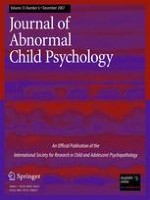01-12-2007
Maternal and Paternal Depressive Symptoms and Child Maladjustment: The Mediating Role of Parental Behavior
Gepubliceerd in: Research on Child and Adolescent Psychopathology | Uitgave 6/2007
Log in om toegang te krijgenAbstract
This study examined parental behaviors as mediators in links between depressive symptoms in mothers and fathers and child adjustment problems. Participants were 4,184 parents and 6,048 10- to 15-year-olds enrolled in the 1998 and 2000 cycles of the Canadian National Longitudinal Survey of Children and Youth. Mothers and fathers self-reported symptoms of depression at Times 1 and 2 and their children assessed parental nurturance, rejection, and monitoring and self-reported internalizing and externalizing problems and prosocial behavior at Time 2. Hierarchical linear modeling showed evidence of mediation involving all three domains of parental behavior. Findings supported the hypothesis that the quality of the child’s rearing environment is one mechanism that carries risk to children of depressed parents. Interventions for parents whose symptoms of depression interfere with parenting responsibilities could help reduce the risk of some childhood disorders.
